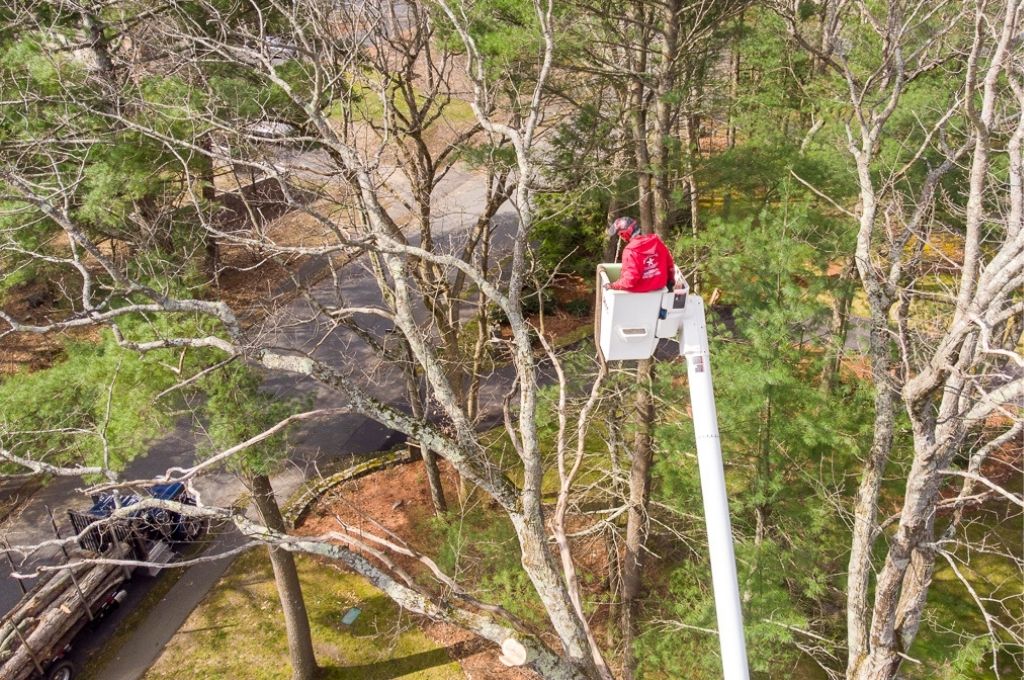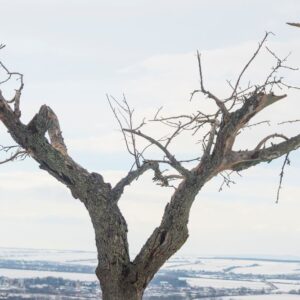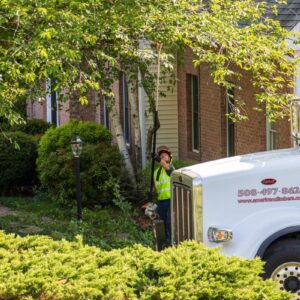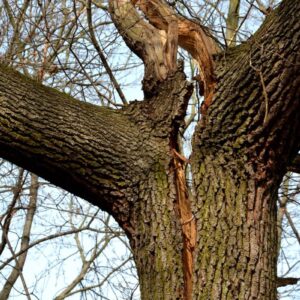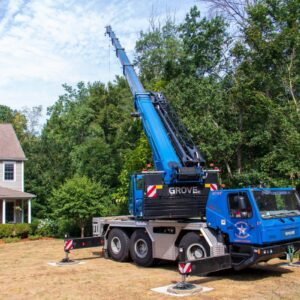When it comes to pruning trees, no two situations are exactly the same. And that's especially true when it comes to pruning large, tall, or mature trees! The tree professionals at American Climbers have to plan a tree pruning job before even making the first cut, decipher the difficulties that may be encountered, determine which equipment is needed, make allowances for tight enclosures, power lines, and steep hills, calculate the risks and the safety measures needed, (and more!) all while keeping the area safe and nearby structures sound.
One of the things that can increase the difficulty of tree pruning is the size of a tree. We love seeing mature trees in neighborhoods, as they provide some great benefits for us all. However, those mature trees still need to be pruned and properly maintained – and that’s not always an easy task.
Keep reading to learn:
- why these huge trees should be pruned (even if it’s not easy),
- some of the difficulties in pruning large or tall trees,
- why pruning large trees typically takes longer than smaller trees, and
- how things like insurance and experience can make a difference in the quality of tree pruning that you receive.
Why Large, Tall & Mature Trees Should be Pruned
The larger a tree gets, the greater the risk of harm to people and structures around it. Long, heavy branches extending over roofs, roads, and patios can break off during nor’easters or summer thunderstorms. Older trees are more prone to decay, root rot, and other defects that can cause it to unexpectedly fall. And when something goes wrong with an exceptionally tall tree (the tallest tree in Massachusetts is over 150 feet tall!), it can hit a lot of things on the way down.
To minimize the risk posed by these enormous trees, we focus on pruning them to:
- remove dead or broken branches,
- raise the canopy (where needed) to allow people and vehicles to pass by, and
- reduce the weight on long, large, and damaged branches to minimize the chance of breakage.
The Process of Pruning Large Trees
You may think that “pruning is pruning” – how different can it really be just because a tree is larger than others?
While the basic principles and techniques are the same, pruning a huge tree is quite different from trimming back a smaller ornamental tree. Not only is it much more dangerous, it also requires additional equipment, training, time, and a more selective approach to choosing which branches to remove.
Getting to the Tree
Whether a tree is wide, tall, or both, sometimes getting to the section of the tree that needs to be pruned is the biggest issue. Most property owners and even most landscapers do not have the proper equipment to reach anything over 10-15 feet. In fact, most landscapers are only insured to work on plants and trees up to 8 or 15 feet above the ground.
At American Climbers, we have cranes, bucket trucks, grapple saws, and climbing equipment that are all geared toward helping us reach the highest parts of almost any tree.
We also have to take into account how to get our equipment close enough to the tree when there are often narrow passageways, surrounding trees or buildings, power lines, uneven surfaces, or other obstacles to accessing the tree.
Making the Cuts
Once the tree is reached, the next phase of the pruning begins – removing branches. Using techniques recommended by the International Society for Arboriculture, we determine which branches to remove to maintain the tree’s structure while lessening the load on longer branches and allowing for more light and air to reach the inner sections of the tree.
We also might remove some branches that could cause damage in the future, are growing incorrectly, are touching other objects (like your roof), or are dead, damaged, diseased, or weakened.
With larger and older trees, it’s important to be selective in choosing branches to cut out. Large pruning cuts, such as when bigger and older branches are removed, often heal poorly on these trees, leaving them vulnerable to diseases and insect infestation. We try to avoid pruning off too many branches or removing too much foliage, and we do not remove any more of the interior branches than is absolutely necessary. Contrary to popular (and uninformed) belief, over-thinning (often called lion-tailing) makes a tree less safe.
Maneuvering the Pruned Tree Branches
When a tree has grown for dozens of years, sometimes the sections of the tree that need to be cut and removed can be quite large! This is where our knowledge, experience, and equipment come in handy, as we have all the tools necessary to safely move cut branches (that may weigh hundreds of pounds!) from the top of the tree down to the ground.
Once on the ground, the ground crew can cut the branches into smaller pieces and load them into the chipper or the log truck, depending on the size and shape of the wood.
Dealing with Dangerous Tree Sections
We also have to deal with branches that are dead, broken, or cracked, which takes skill and patience. In some cases, we have to prevent the damaged branches from falling, which could harm or injure people or buildings below. Luckily, we have methods for extracting and removing these dangerous tree sections before they can do any harm. This is one of the reasons it’s important to have your trees professionally pruned before any storms; extreme weather can shake loose those dead or broken branches, causing them to fall unexpectedly or even turning them into projectiles in strong winds.
Using Proper Pruning Techniques
Pruning is a delicate procedure that, if done incorrectly, can cause irreversible harm to your tree. Pruning or trimming a tree is a lot different from trimming your hair – the sections that you remove don’t just grow back as before! Plus, pruning in the wrong way can leave unsightly stubs, create jagged branch ends, and cause wounds that become an invitation for pests and disease to enter your tree.
Improper pruning, such as tree topping or removing too much of the tree canopy, can remove the tree’s ability to photosynthesize due to a lack of leaves. Photosynthesis is how a tree generates energy for growth and healing. If it doesn’t have enough energy, your tree will become stressed and other issues are sure to follow.
See the types of pruning we may perform, depending on what is needed for your tree.
Disposing of Large Tree Branches & Debris
Once the tree is pruned, depending on the size of the tree, there can be a lot of wood, twigs, branches, and leaves. While some homeowners may choose to keep some of the wood to use for firewood or may want the chipped pieces to use as wood mulch, most find that the sheer quantity of wood is more than they need. This is even more true in tree removals when the entire tree is cut into sections.
Part of our commitment to pruning your trees is to properly dispose of the green waste so that you don’t have to deal with it. That’s why our ground crew will use equipment such as a wood chipper and/or a log truck to remove those large sections of wood from your property, ensuring that your yard is similar to how we found it.
Not all companies have the capability or equipment to remove the large quantity of branches, wood, and debris that is created when pruning large trees, but American Climbers does!
Pruning Large Trees Can Take Longer And May Cost More
Now that we’ve explained an overall view of the process of a large tree pruning, you may understand why pruning large trees can not only take longer than pruning smaller trees, but also why it generally costs more. For example,
- More equipment, and larger equipment, is needed - and this equipment usually requires a specialized operator
- In some cases, more crew members are needed to safely and efficiently tackle the tree
- More planning is needed, especially if it is difficult to reach the tree(s)
- The safety risks are greater, so more training is required of the crew members
- We have the proper insurance to cover working at extreme heights, but that adds to overall costs as well
This is why we always need to see your trees in person to give you an estimate for your tree pruning or removal job. The estimator is calculating the equipment, staff, and time needed to complete your pruning job depending on the location, size, and health of the tree.
What is Considered a Big or Large Tree?
One of the amazing things about living in Massachusetts is the quantity of large, mature trees that can grow and thrive here.
A big or large tree is any tree that can’t be pruned from the ground. We can often prune ornamental trees using a chainsaw, lopper, or even a stick pruner or chainsaw. But as a tree grows, so do the tools needed to reach it. Many trees such as white oak, various kinds of pine, and tulip trees can reach up to 100 feet tall, meaning that we have to send climbers up the tree and/or bring in equipment like a crane or bucket truck to reach the upper branches.
American Climbers Can Handle Your Large Tree Pruning Needs
Do you have a large tree? Think carefully about who you hire. Landscaping companies and even some tree companies are not always properly insured for working at heights, which can leave you open to financial or even legal difficulties if something goes wrong.
American Climbers is properly insured for this kind of tree work and spends the time to train and equip employees not only on how to do their job, but how to do it in the safest way possible. Tree work can be very dangerous, especially at great heights and with powerful equipment.
Speaking of equipment, American Climbers has the necessary equipment to properly prune tall trees, from bucket trucks, cranes, and grapple saws to reach the trees to log trucks and chippers to dispose of the green waste. We also have the proper safety equipment such as helmets, ear protection, harnesses, chainsaw pants, communication devices, and more to help us do our job more efficiently and safely.
Because we have been working in the Metro-West region of Massachusetts since 1996, we also have the experience, and the knowledge gained from those many years of experience, to be able to prune your trees in a high-quality manner.
Contact us today to request a tree pruning quote and schedule an estimate for pruning your large or tall trees!
Blog Topics
Recent Posts
What's Happening? Stay Informed!
Stay on top of local events, pest and disease updates, tree and landscape tips, and more. Delivered straight to your inbox each month.

